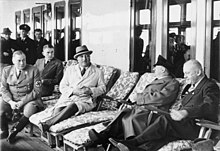Wilhelm Brückner


Wilhelm Friedrich Karl Brückner (born December 11, 1884 in Baden-Baden , † August 20, 1954 in Herbsdorf ) was a German officer , National Socialist and long-time chief adjutant of Adolf Hitler .
Live and act
Youth and First World War
Brückner was a son of Wilhelm Brückner and his wife August, b. Niebecker. Brückner grew up in Baden-Baden and passed his Abitur at the secondary school there. He then studied law and economics in Strasbourg , Freiburg , Heidelberg and Munich . In 1905 he renounced the Corps Transrhenania Munich , but was dismissed after four months as a fox and came into SC disrepute .
In the First World War , he was in a Bavarian infantry regiment officer and as Lieutenant adopted. After the war he joined the Epp Freikorps and participated in the 42nd Rifle Regiment as a member of the Reichswehr in the suppression of the Munich Soviet Republic .
Life in the Weimar Republic until 1930
Towards the end of 1919 Brückner went back to university, but became a film recording technician for three years.
Brückner joined the NSDAP for the first time at the end of 1922 . He had met the party chairman Adolf Hitler as a soldier in 1919. On February 1, 1923, Brückner was appointed leader of the Munich SA regiment. In the same year he took an active part in the Hitler putsch . After the coup was suppressed, he was arrested and sentenced to a year and a half imprisonment, but released after four and a half months. After his release from prison, Brückner worked in rescue organizations of the banned NSDAP. In the spring of 1925, he did not rejoin the NSDAP. Instead, he earned his living until 1927 as the third general secretary of the Association for Germans Abroad (VDA). During the next few years he lived on his income as a commercial representative until he found a permanent position at the German Foreign Institute in 1929.
Activity as Hitler's adjutant (1930 to 1940)
On August 1, 1930, Brückner was appointed to the group of Adolf Hitler's adjutants and bodyguards. On September 1, he rejoined the NSDAP ( membership number 298.623) and the SA. In the latter he was promoted to SA-Oberführer in 1932, to SA-Gruppenführer in 1933 and finally to SA-Obergruppenführer on November 9, 1934. Within Hitler's entourage, Brückner soon rose to the rank of chief adjutant, making him one of the closest employees of the party leader and, from 1933, of the head of government Hitler. Due to its simplicity and affability, it was very popular with petitioners and everyday visitors to the Reich Chancellery.
At his own request, Brückner became a corps loop bearer of Transrhenania in 1934 . “Anyone who is so close to the Führer cannot be a bad person” .
As a result of a car accident in the same year, Brückner was able to refer Hitler to the attending doctor Karl Brandt . Brückner was a member of the Reichstag from 1936 in the tenth and eleventh electoral terms . On January 15, 1936, Brückner was granted honorary citizenship of Detmold , which was revoked on November 9, 1945. With the outbreak of the Second World War, Brückner lost its importance. He had to give way more and more to the adjutants of the Wehrmacht and the SS, which were rapidly gaining importance due to the war. On October 18, 1940, he was unexpectedly dismissed because of a dispute with Hitler's house manager Arthur Kannenberg . The mastermind was most likely Martin Bormann . Julius Schaub took over the position of chief adjutant in his place .
War participation and post-war period
Brückner joined the Wehrmacht in 1941 , where he achieved the rank of colonel during the war . In November 1944 he was seriously wounded. At the end of the Second World War, Brückner was taken prisoner by the Americans, where he remained until 1948.
literature
- Joachim Lilla u. a .: extras in uniform - the members of the Reichstag 1933–1945. A biographical handbook with the inclusion of the Volkish and National Socialist members of the Reichstag from 1924. Düsseldorf 2004, p. 66 f.
Web links
- Wilhelm Brückner in the database of members of the Reichstag
- Wilhelm Brückner in the Internet Movie Database (English)
- Newspaper article about Wilhelm Brückner in the 20th century press kit of the ZBW - Leibniz Information Center for Economics .
Individual evidence
- ^ Winfried Hofmann, Herbert Neupert , Heinz Schreck, Christian Theusner: History of the Corps Transrhenania 1866–1990 . Munich 1991; Kösener corps lists 1960, 115 , 214.
| personal data | |
|---|---|
| SURNAME | Brückner, Wilhelm |
| ALTERNATIVE NAMES | Brückner, Wilhelm Friedrich Karl (full name) |
| BRIEF DESCRIPTION | German military; Chief adjutant of Adolf Hitler, politician (NSDAP), MdR |
| DATE OF BIRTH | December 11, 1884 |
| PLACE OF BIRTH | Baden-Baden |
| DATE OF DEATH | 20th August 1954 |
| Place of death | Herbsdorf , today Nußdorf (Chiemgau) |

